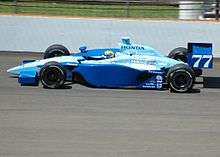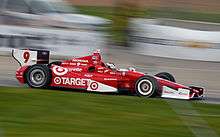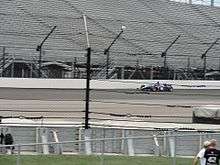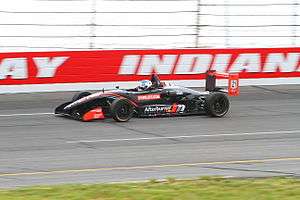IndyCar
 | |
| Sport | Auto Racing |
|---|---|
| Category | Open-wheel cars |
| Jurisdiction |
|
| Founded | 1994[1] |
| Affiliation | ACCUS-FIA |
| Affiliation date | 1996 |
| Headquarters | Indianapolis, IN |
| President | Jay Frye |
| Official website | |
|
indycar | |
Indy Racing League, LLC, doing business as IndyCar (stylized INDYCAR), is an American-based auto racing sanctioning body for Indy car racing and other disciplines of open wheel car racing. The organization sanctions four racing series: the premier IndyCar Series[2] with its centerpiece the Indianapolis 500, and developmental series Indy Lights, the Pro Mazda Championship and the U.S. F2000 National Championship, which are all a part of The Road To Indy. IndyCar is recognized as a member organization of the FIA through ACCUS.
The sanctioning body was formed in 1994 under the name Indy Racing League, and began competition in 1996. The trademark name INDYCAR was officially adopted on January 1, 2011. The sport of open-wheel car racing itself, also historically referred to as Championship Car racing or Indy racing, traces its roots to as early as 1905. It is the fourth major sanctioning body to govern the sport of Indy car racing, following AAA, USAC, and Champ Car.
IndyCar is owned by Hulman & Company, which also owns the Indianapolis Motor Speedway complex and the Clabber Girl brand.
Sanctioned series
IndyCar Series
The League's premier series debuted in 1996 under the name Indy Racing League. The series adopted the name Indy Racing League IndyCar Series in 2003. With Verizon as corporate sponsor since 2014, the series has been known as the Verizon IndyCar Series.
The series initially raced exclusively on oval tracks, as the series was founded partly in response to the increasing prominence of road and street courses on the CART schedule. In 2005, the series abandoned its unofficial ovals-only stance, and added three road–street course events. By 2009, the series had a roughly 50/50 split of ovals and road/street courses. Presently, the series currently runs one-third of its schedule on ovals and the rest on road and street circuits.
Indy Lights
Indy Lights is the development series for the IndyCar series. The Indy Lights concept traces its roots back the USAC Mini Indy Series of the late 1970, and the CART ARS/Indy Lights series that began in 1986. The current Indy Lights series debuted in 2002 under the name Infiniti Pro Series. After the 2008 open wheel unification, the Indy Lights name returned. The Indy Lights typically run as support races to IndyCar Series races, but occasionally has run stand-alone races, or as a support race of other events. The series is now promoted by Andersen Promotions.
Pro Mazda Championship
The Pro Mazda Championship presented by Goodyear is an open-wheel racecar driver development series in North America. Competitors use spec Formula Mazda race cars built by Star Race Cars. The original series, using first-generation tube-frame cars started in the early 1990s, with the current, high-tech, carbon-fiber car released in 2004. The series has historically included road courses, street courses, and ovals. The series' primary sponsors are Mazda and Cooper Tire and the cars, while purpose built for the track with carbon fiber monocoques, are powered by 250 horsepower Mazda 'Renesis' rotary engines. The series' stated goal is "to develop new race driving talent." In 2010, the series became a part of The Road to Indy. In 2013 the series' promotion was taken over by Andersen Promotions.
U.S. F2000
USF2000 is a series the organisation started sanctioning in 2010. Originally started in 1991 and folded in 2006, it was restarted in 2010 as part of the "Road to Indy" ladder series promoted by Andersen Promotions. The series utilizes tube frame Formula Ford chassis fitted with larger Mazda MZR four cylinder engines and wings and slicks and was originally based on the Formula Continental rules formula.
History
IndyCar name
"IndyCar" or "Indy Car" are sometimes used as a descriptive name for championship open-wheel auto racing in the United States. The Indy car name derived as a result of the genre's fundamental link to the Indianapolis 500 Mile Race (often referred to as the "Indy 500"), one of the most popular auto races in the world.
Beginning in 1990, the term Indy car was often used to describe the race cars in the events sanctioned by CART, which had become the dominant governing body for open-wheel racing in the United States. The Indianapolis 500, however, remained sanctioned by USAC. CART recognized the Indy 500 on its schedule, and awarded points for finishers in the race from 1990 to 1995 despite not sanctioning it. The two entities operated separately, but utilized the same equipment.
In 1992, the Indianapolis Motor Speedway registered the IndyCar trademark with the United States Patent and Trademark Office and licensed it to CART, which renamed its championship the IndyCar World Series. All references to the name "CART" were decidedly prohibited, as the series sought to eliminate perceived confusion from casual fans with the term kart.
During the 1996 season, the IndyCar mark was the subject of a fierce legal battle. Prior to the 1996 season, Indianapolis Motor Speedway President Tony George had created his own national championship racing series, the Indy Racing League. In March 1996, CART filed a lawsuit against the Indianapolis Motor Speedway in an effort to protect their license to the IndyCar mark which the Indianapolis Motor Speedway had attempted to terminate.[3] In April, the Indianapolis Motor Speedway filed a countersuit against CART to prevent them from further use of the mark. Eventually a settlement was reached in which CART agreed to give up the use of the IndyCar mark following the 1996 season and the IRL could not use the name before the end of the 2002 season.[4]
Following a six-year hiatus, Indy Racing League, LLC announced it would rename their premier series the IndyCar Series for the 2003 racing season. Brickyard Trademarks, Inc., a subsidiary of Indianapolis Motor Speedway Corporation, is the current owner of the IndyCar mark and licenses that mark to the Indy Racing League for use in connection with the IndyCar Series. CART (and its successor Champ Car) races outside the United States were still permitted to use the Indy moniker, such as the Toronto Molson Indy and Lexmark Indy 300, though the distinction is moot now, as the two series have unified. Post-unification, a heavy emphasis has been placed on deemphasizing the legal entity name and its initials and replacing it with the IndyCar name. This became official on January 1, 2011, as Indy Racing League LLC adopted as its trade name INDYCAR (but not its legal business name). All legal and official documents such as race reports, investigative documents, and broadcast disclaimers state "Indy Racing League LLC." Some documents may also include "d/b/a INDYCAR."
Split with CART
The Indy Racing League was founded in 1994 by Tony George and began racing in 1996. CART had sanctioned Indy car racing since 1979, when the organization broke away from USAC. George blueprinted the IRL as a lower-cost open-wheel alternative to CART, which had become technology-driven and dominated by a few wealthy multi-car teams, much like Formula One. It initially attracted some of the smaller teams who believed in the vision presented by Tony George.
The split between the IRL and the CART governing body was acrimonious, and both series suffered because of it. The rivalry between competing groups of fans was most active on the Internet, especially on motorsports message boards, and tended to affect any attempts at impartial views of either racing series.
The most bitter point of conflict between CART and the IRL was the Indianapolis 500, long considered the crown jewel of North American motorsports. Although it was unquestionably the flagship race on the CART schedule, the Indy 500 was never sanctioned by CART and continued to be sanctioned by USAC until taken over by the Indy Racing League. George felt that CART treated the Indy 500 just like any other race, and did not give the race the respect he felt it deserved. Starting with the first IRL season, Tony George reserved 25 of the 33 spots in the Indy 500 starting grid for cars from full-time IRL teams.[5] This was likely done because in 1979, when CART started their own series to compete with USAC, the Indy 500 refused entries from CART teams and those teams responded by suing the speedway. In 1996, CART retaliated by scheduling what was supposed to become its new showcase event, the U.S. 500, at Michigan International Speedway on Memorial Day, the traditional date for the Indy 500. The inaugural U.S. 500 was an unmitigated disaster when there was a massive crash coming to the green flag. Although CART continued to run the race until 1999, it never drew fan interest like the Indy 500. Although modified in 1999, the initial Indy 500 policy toward CART had already become less significant when the IRL came out with their own chassis specifications in 1997 and CART spec chassis were no longer legal.
The new 1997 technical rules featured less expensive chassis and "production-based" engines. In addition, the IRL series ran exclusively on oval tracks. This situation allowed many American drivers from the midget and sprint car ranks to graduate to Indycars the way the greatest stars of Indy racing like A.J. Foyt, Mario Andretti, Johnny Rutherford, and the Unsers had. For the next few years, although some former CART drivers moved over to the IRL, no CART teams competed at the Indy 500. CART fans felt the Indy 500 was diminished by the absence of the CART teams, but the mass of open wheel oval track fans that support the thousands of midget and sprint car racers that compete on a weekly basis throughout the U.S. were thrilled to see drivers like Tony Stewart and Billy Boat getting an opportunity to drive for topnotch Indycar teams. Many oval track race fans, who had switched over to watching NASCAR during the CART era, came back to Indy car racing, now that there weren't any more CART style street races.
At its inception, the series and George himself were criticized by members of the media and some CART competitors. Like any brand new series, the IRL's early seasons consisted of sparse schedules and inexperienced teams, even in the Indy 500. Eventually, the schedule expanded and the new technical rules produced some truly exciting racing, especially on the 1.5 mile super speedways like Texas Motor Speedway. The IRL began to draw top teams from CART starting in 2000, contributing to the latter's bankruptcy, re-branding as Champ Car in 2003[6], and ultimate demise and absorption by the IRL in 2008.
Although successful in eventually absorbing Champ Car, the IndyCar Series has now become similar in many ways to the CART series from which it separated and its related European open-wheel formula counterparts: former prominent CART teams such as Chip Ganassi Racing and Team Penske are frequent race winners, there is a strong contingent of foreign-born drivers, the cars are increasingly electronic and aero dependent and the schedule includes more road and street courses than oval tracks. Despite the controversies of years past.
Unification with Champ Car
On January 23, 2008, Tony George offered Champ Car management a proposal that included free cars and engine leases to Champ Car teams willing to run the entire 2008 IndyCar Series schedule in exchange for adding Champ Car's dates at Long Beach, Toronto, Edmonton, and Australia to the IndyCar Series schedule, effectively reuniting American open-wheel car racing.[7] The offer was initially made in November 2007.[7] On February 10, 2008, Tony George, along with IRL representatives Terry Angstadt and Brian Barnhart, plus former Honda executive Robert Clarke, traveled to Japan to discuss moving the Indy Japan 300 at Twin Ring Motegi.[8] Moving that race, or postponing it, would be required in order to accommodate the Long Beach Grand Prix, which was scheduled for the same weekend.[8] Optimism following the meeting was high.[9]
In February 2008, Indy Racing League founder and CEO Tony George and owners of the Champ Car World Series completed an agreement to unify the sport for 2008.[10] The result was that the Champ Car World Series was suspended except for the Long Beach Grand Prix. Many of the former Champ Car teams moved to the IndyCar Series using equipment provided by the League.
Randy Bernard was announced as the new IRL CEO in February 2010.[11] In 2011, the sanctioning body dropped the Indy Racing League name, becoming IndyCar to reflect the merged series. The new Dallara DW12 racecar was introduced for the 2012 season. IndyCar collaborated with DreamWorks Animation to launch comedy film Turbo in 2013. Bernard was fired in October 2012, and replaced by Mark Miles.
Driver safety
Driver safety has also been a major point of concern, with a number of drivers seriously injured, particularly in the early years of the series. There have been five fatal crashes in the history of the series. Compared to road racing venues, the lack of run-offs on oval tracks, coupled with higher speeds due to the long straights and banked turns, means that there is far less margin for error. Car design was attributed as a leading cause of early injuries, and the series made improvements to chassis design to address those safety concerns. Following a series of spectacular high-profile accidents in 2003, including American racing legend Mario Andretti and former champion Kenny Bräck, as well as the death of Tony Renna in testing at Indianapolis, the IRL made additional changes to reduce speeds and increase safety.
IndyCar was the first racing series to adopt the SAFER soft wall safety system, which debuted at the Indianapolis 500 and has now been installed at almost all major oval racing circuits. The SAFER system research and design was supported and funded in large part by the Hulman-George family and the Indianapolis Motor Speedway.
Fatalities





Gallery
 Roberto Moreno practicing the 2007 Indianapolis 500.
Roberto Moreno practicing the 2007 Indianapolis 500.
 The 2012 DW12 chassis driven by Scott Dixon.
The 2012 DW12 chassis driven by Scott Dixon.

See also
- Indianapolis Motor Speedway
- Indianapolis Motor Speedway Radio Network
- American Automobile Association
- United States Auto Club
- Champ Car
- List of IndyCar Series teams
- List of IndyCar Series racetracks
- List of American Championship Car Rookie of the Year Winners
- List of American Championship car racing point scoring systems
References
- ↑ 2011 Las Vegas Accident Information
- ↑ "IndyCar lands Title Sponsor". IndyStar.com. Archived from the original on November 6, 2009. Retrieved 2009-11-03.
- ↑ 1948-, Whitaker, Sigur E.,. The Indy Car wars : the 30-year fight for control of American open-whell racing. Jefferson, North Carolina. p. 76. ISBN 9781476619804. OCLC 926914971.
- ↑ 1948-, Whitaker, Sigur E.,. The Indy Car wars : the 30-year fight for control of American open-whell racing. Jefferson, North Carolina. p. 81. ISBN 9781476619804. OCLC 926914971.
- ↑ 1948-, Whitaker, Sigur E.,. The Indy Car wars : the 30-year fight for control of American open-whell racing. Jefferson, North Carolina. p. 70. ISBN 9781476619804. OCLC 926914971.
- ↑ 1948-, Whitaker, Sigur E.,. The Indy Car wars : the 30-year fight for control of American open-whell racing. Jefferson, North Carolina. p. 107. ISBN 9781476619804. OCLC 926914971.
- 1 2 "Tony George Makes an Offer for Unity". SpeedTV.com. 2008-01-23. Archived from Tony George Makes an Offer for Unity the original Check
|url=value (help) on 2008-01-27. Retrieved 2008-01-23. - 1 2 "George off to Japan in pursuit of unification". IndyStar.com. 2008-02-09. Archived from the original on 2008-02-18. Retrieved 2008-02-13.
- ↑ "Official optimistic IRL-Champ Car merger talks will continue". IndyStar.com. 2008-02-12. Archived from the original on November 6, 2011. Retrieved 2008-02-13.
- ↑ "Done Deal". IndyCar.com. Archived from the original on 2008-03-13. Retrieved 2010-08-22.
- ↑ Lewandowski, Dave (2010-02-02). "Meet the CEO". IndyCar Series. Indy Racing League. Retrieved 2010-02-02.
- ↑ "AP".
External links
- Official website
- IndyCar at Curlie (based on DMOZ)